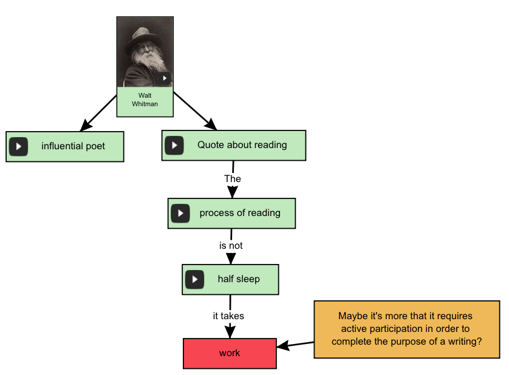This post is written by Mary Chase, Ph.D., an expert in curriculum design, literacy education, and technology integration.
In 1871, the poet and thinker Walt Whitman wrote:
… the process of reading is not a half sleep, but, in highest sense, an exercise, a gymnast's struggle; that the reader is to do something for himself, must be on the alert, must himself or herself construct indeed the poem, argument, history, metaphysical essay—the text furnishing the hints, the clue, the start or frame-work. Not the book needs so much to be the complete thing, but the reader of the book does. That [would result in] a nation of supple and athletic minds, well-train'd, intuitive, used to depend on themselves, and not on a few coteries of writers.
When we picture a reader, we imagine a person leaning over a text, still and silent. However, if we could peek into the reader’s “thought bubble,” we’d see instead someone wrestling with ideas, leaping between past experience and new applications, and dismantling words and phrases. Reading isn’t a passive endeavor.
Reading scholar Kenneth Goodman famously described reading as a “psycholinguistic guessing game.” At the time, the late 1960s, reading was being positioned as an exact science focusing primarily on word and letter identification. Goodman argued that the role of the reader was more about graphic cues that led to attempts at interpretation involving both long-term, short term and working memory as well as background knowledge.
Goodman’s research, which parallels developmental theory, suggests that there is more to reading than identifying and translating sound-letter relationships. These are mere surface levels of text, useful to the decoding process, but frequently confusing, especially in English, which is not a purely phonetic language. Further, such rote decoding is not representative of the processes of skilled readers. Instead, these readers move through ever-deepening cycles of understanding moving from the visual/perceptual to syntax (grammatical relationships) and meaning. Perception is important, of course, as are sound/symbol relationships. They are not at the core of reading, however. Otherwise, how would sightless and hearing-impaired students ever learn to interpret text?
What does this mean for instruction, though? How can teachers access, assess and support these internal processes? For many years, teachers relied on read-aloud and question/answer approaches. More recently, visual representations of reading—concept maps, for example—are being used in the classroom and are even more useful. There is limited space on paper, and only so many times a student can erase
and re-draw connecting lines before patience runs out.
 That’s where groundbreaking tools such as Ideaphora come in. As students encounter text, it becomes malleable—they can move words and text around to show affinities and categories, and use color and shape to show what words and ideas warrant further investigation. As students struggle to find meaning, they develop personalized strategies that will support them as they encounter increasingly sophisticated texts.
That’s where groundbreaking tools such as Ideaphora come in. As students encounter text, it becomes malleable—they can move words and text around to show affinities and categories, and use color and shape to show what words and ideas warrant further investigation. As students struggle to find meaning, they develop personalized strategies that will support them as they encounter increasingly sophisticated texts.
Once students’ reading processes are visible, teachers can intervene and correct errors and misconceptions, and push student thinking forward while the students are still engaged in their reading, rather than afterwards in a test. Both teaching and learning benefit from this approach.
Try this in your classroom as a way to keep tabs on student reading, or even assign pairs to respond to each other—and as always, let Ideaphora know how it’s going by contacting info@ideaphora.com.
Learn more about Ideaphora Classroom and consider participating in the free classroom pilot program to use it with your students.

